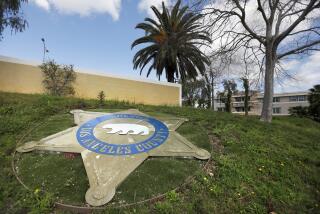Work crews hustle as San Pedro bluff slides slowly into the sea
A coastal bluff in San Pedro is slowly buckling and sliding toward the ocean, splitting open a coastal highway with sinkholes, cracks and deep crevices that are widening day by day.
Crews are hurrying to move sewer and water lines and utility poles and to reroute two major storm drains that join under Paseo Del Mar. Los Angeles city engineers have been monitoring the slide’s movement on the 100-foot-high bluff next to White Point Nature Preserve since cracks and fissures started to open up last spring.
Authorities indefinitely closed a 900-foot stretch of the highway between Weymouth and Western avenues in September, putting up warning signs and barricades to keep out drivers and pedestrians.
PHOTOS: Cracks and fissures along a San Pedro coastal road
Now, the highway and sidewalk have sunk more than a foot, opening deep crevices in the asphalt that cut a jagged diagonal line across the two-lane roadway. A wooden fence that once ran a straight line along the road now bends abruptly toward the ocean, a change that happened in just days. Cracks have also split open the earth in the adjacent nature preserve.
Work crews are keeping a watchful eye and taking daily measurements as the land creeps seaward. In the last week, the movement has accelerated to about half an inch per day.
City engineers, who have classified the slide as a coastal bluff failure, say it is far enough from a nearby neighborhood that no buildings are at risk of falling into the ocean.
Even so, Tammy Thalman, 49, has heard jokes circulating through the neighborhood that if the bluff continues to slip away, eventually everyone will have oceanfront property.
“We’re a little concerned,” she said, even though she lives several blocks from the slide and across the street from the ocean.
A few months ago Bob Simpson, 69, a retired retail clerk who lives in one of the houses closest to the slide, started noticing small cracks in the asphalt on Paseo del Mar. Then one day the road sank, creating a jarring dip.
“You’d be driving, then all of a sudden, boom, you’re a few feet lower than you were,” he said.
“I’m not losing any sleep over it, but I’m thankful I’m on this side of the street instead of the ocean side of it,” Simpson said. “Maybe some night when I’m sound asleep, I’ll hear some rumbling noise and that’ll be it.”
Officials don’t know how much farther the ground is going to shift, but they are bracing for the possibility that chunks of the bluff could shear off and slide toward the sea.
“As long as the ground is moving, the road will be closed,” said Vince Jones, Los Angeles deputy city engineer. “At some point in time it may stop sliding, but we just don’t know how long that will be.”
The most pressing work started a few weeks ago after inspections showed that a joint on a 41/2-foot-wide Los Angeles County stormwater pipe had separated.
Contractors are working seven days a week, 10 hours a day, manning loaders and excavators that are carving new trenches to reroute two major storm drain pipes away from the moving earth. The project could take four more weeks, but the hope is to finish before any heavy rains, which could send storm water rushing into the area, rupture the pipe and further loosen the unstable slope.
“If this fails,” said Hector Bordas, area engineer for the Los Angeles County Department of Public Works, “it means our pipe and storm drain system will also fail.”
Officials aren’t sure what’s causing the movement, but they said the waves eating away at the base of the bluff 100 feet below could be causing instability.
Though the slide seems to be isolated a good distance from homes, not everyone is resting easy.
A bluff-top breaking off into the ocean wouldn’t be unheard of on the south-facing side of the Palos Verdes Peninsula, where weak, slippery rock formations that dip toward the sea make the earth prone to landslides.
In 1929, a residential area two miles down the coast on Paseo Del Mar started sinking into the ocean, leaving behind a post-apocalyptic-looking bowl littered with chunks of concrete and asphalt that became known as the Sunken City. A chunk of the fenced-off parcel collapsed into the ocean in July 2010.
Starting in the 1950s, the Portuguese Bend landslide — one of the most famous in California — rearranged some 260 acres in Rancho Palos Verdes. And when the Ocean Trails Golf Course was under construction in 1999, a 16-acre section — including the 18th hole — slid dramatically into the ocean. In December 2009, a chunk of earth fell from a cliff in San Pedro less than a mile up the coast from the current landslide.
Still, talk of another slide is enough of a curiosity that it draws a steady stream of visitors.
“People make it a regular attraction to come by and see if the cracks have gotten bigger,” said Joshua West, an assistant naturalist for the Palos Verdes Peninsula Land Conservancy.
“It could fall into the ocean, but I’m not worried,” he added. “When you’ve lived here a long time, you’ve seen a lot of things fall into the ocean.”
PHOTOS: Cracks and fissures along a San Pedro coastal road
More to Read
Start your day right
Sign up for Essential California for news, features and recommendations from the L.A. Times and beyond in your inbox six days a week.
You may occasionally receive promotional content from the Los Angeles Times.







